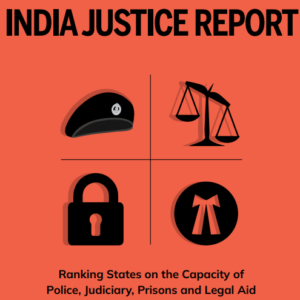GS2 – Polity

Context:
Tata Trusts, in collaboration with a network of civil society organizations, has released the 2025 edition of the India Justice Report. The report evaluates the performance of states and union territories across 24 indicators, covering the four core pillars of the justice system—police, judiciary, prisons, and legal aid.
Insights from the Report
- Judiciary
- Judge-to-Population Ratio:
India has only 15 judges per million people, which is significantly lower than the 1987 Law Commission’s recommendation of 50 judges per million. - Vacancies in High Courts:
Nearly one-third (33%) of the sanctioned judge positions in High Courts remain vacant. Gujarat has the highest number of vacancies among both High Court judges and supporting staff. - Budget Allocation:
Judicial spending remains minimal, with the national per capita expenditure at only ₹182. No state allocates more than 1% of its total annual budget to the judiciary. - Gender Representation:
Women account for 38% of judges in the district judiciary, a higher proportion than in High Courts and the Supreme Court, where female representation stands at just 6%. Among the 25 High Courts, only one has a woman Chief Justice. - Representation of SCs/STs:
The participation of marginalized communities is low, with Scheduled Castes at 14% and Scheduled Tribes at 5% in the district judiciary. Of the 698 High Court appointments since 2018, just 37 judges belong to SC or ST communities.
- Police
- Personnel Shortage:
The police-population ratio is 155 personnel per 100,000, which is well below the sanctioned strength of 197. On average, one civil police officer serves 831 individuals. - Women in the Force:
Less than 1,000 women hold senior positions among the 20.3 lakh total police personnel. No state or UT has met the reserved quota for women in the police force. At the current rate, it could take 24 years to achieve 33% female representation. Notably, Bihar leads in the proportion of women in its police force. - SC/ST Representation:
SCs comprise 17% and STs 12% of the police force. Only Karnataka has successfully fulfilled SC, ST, and OBC reservation quotas in both police and judiciary. - Surveillance Infrastructure:
83% of police stations are equipped with at least one CCTV camera, whereas 17% still lack any CCTV surveillance. - Forensic Backlog:
Though the number of forensic laboratories has increased slightly—from 94 in 2020 to 110 in 2024—this growth has not kept pace with demand. Over 30,000 cases requiring forensic analysis are currently pending.
- Prisons
- Overcrowding:
The national average occupancy rate in prisons is 118.5%. States like Uttarakhand (183%), Uttar Pradesh (176%), and Delhi (174%) report alarmingly high congestion. Uttar Pradesh has the most overcrowded prisons, also reflecting a shortage of High Court judges. - Undertrial Population:
A massive 77.1% of prisoners are undertrials—up from 69% a decade ago. In 20 states/UTs, over 20% of undertrial detainees have been in custody for 1-3 years. There is also disproportionate incarceration of Dalits, Adivasis, and Muslims among undertrials.
- Legal Aid
- Poor Coverage:
In many states, there is just one legal aid lawyer for every 10,000–30,000 eligible individuals. Deficiencies such as inadequate training, poor working conditions, and delays in remuneration continue to impact service delivery. - Low Awareness:
Public understanding of the right to free legal aid remains low, leaving many eligible citizens without legal support. - Budget Constraints:
The per capita spending on legal aid is a mere ₹6 per annum, indicating systemic underfunding of this essential service.




